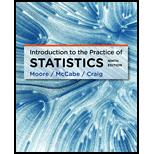
Concept explainers
(a)
Section 1:
To find: The error degrees of freedom for Model 1.
(a)
Section 1:
Answer to Problem 17E
Solution: There are 200 error degrees of freedom in Model 1.
Explanation of Solution
Calculation: The two models have been provided in the problem. Model 1 discusses the effect of Gene expression
Here, the variable
The degrees of freedom for the model are calculated as
The total degrees of freedom are calculated as:
The error degrees of freedom are calculated as
Section 2:
To find: The error degrees of freedom for Model 2.
Section 2:
Answer to Problem 17E
Solution: There are 199 error degrees of freedom in Model 2.
Explanation of Solution
Calculation: The two models have been provided in the problem. Model 2 discusses the effect of Gene expression
Here, the variable
The degrees of freedom for the model are calculated as
The total degrees of freedom are calculated as
The error degrees of freedom are calculated as
(b)
To test: The null hypothesis that “the serotonin gene regression coefficient is equal to zero” against “it is not equal to zero,” and the corresponding test statistic and its P-value in Model 1.
(b)
Answer to Problem 17E
Solution: The result is significant, that is, the regression coefficient for gene expression
Explanation of Solution
Calculation: The null hypothesis to test whether the variable gene expression
The alternative hypothesis that the variable for gene expression
The level of significance is 0.05. It is provided that
The test statistic
The critical value of test statistic
The P-value for the test is calculated as
Conclusion: The P-value is less than the level of significance. Also, the test statistic results are
Hence, the null hypothesis gets rejected, that is, the result is significant.
(c)
Section 1:
To test: The null hypothesis that “the serotonin gene regression coefficient is equal to zero” against “it is not equal to zero,” and the corresponding test statistic and its P-value for Model 2.
(c)
Section 1:
Answer to Problem 17E
Solution: The result is significant, that is, the regression coefficient for gene expression
Explanation of Solution
Calculation: The null hypothesis to test whether the regression coefficient for gene expression
The alternative hypothesis that the regression coefficient for gene expression
The level of significance is 0.05. It is provided that
The test statistic
The critical value of test statistic
The P-value for the test is calculated as
Conclusion: The P-value is less than the level of significance. Also, the test statistic results are
Hence, the null hypothesis gets rejected, that is, the result is significant.
Section 2:
To test: The null hypothesis that “the rule-breaking composite coefficient is equal to zero” against “it is not equal to zero,” and the corresponding test statistic and its P-value for Model 2.
Section 2:
Answer to Problem 17E
Solution: The result is significant, that is, the coefficient for rule-breaking composite
Explanation of Solution
Calculation: The null hypothesis to test whether the coefficient of rule-breaking composite
The alternative hypothesis that the explanatory variable rule-breaking composite
The level of significance is 0.05. It is provided that
The test statistic
The critical value of test statistic
The P-value for the test is calculated as
Conclusion: The P-value is less than the level of significance. Also, the test statistic results are
Hence, the null hypothesis gets rejected, that is, the result is significant.
(d)
Section 1
Whether there lies a positive relationship between “the serotonin gene receptor expression level” and “popularity” after adjusting for rule-breaking.
(d)
Section 1
Answer to Problem 17E
Solution: The coefficients of the variables “gene expression” and “rule breaking” are positive. It highlights that there lies a positive relationship between the coefficients of the two variables in both the models.
Explanation of Solution
Section 2
To find: The comparison of upsurge in popularity when the gene expression increases by one unit and the rule breaking composite remains fixed.
Section 2
Answer to Problem 17E
Solution: When the variable gene expression is increased by one unit, the popularity increases by 0.204 units in Model 1, and there is an increase in popularity by 0.161 units in Model 2.
Explanation of Solution
Calculation: The regression model for Model 1 can be written as
When the gene expression is increased by 1 unit, the increase in the popularity is calculated as follows:
Also, the regression model for Model 2 can be written as
When the gene expression is increased by 1 unit, keeping all other variables constant, the increase in popularity is calculated as follows:
Want to see more full solutions like this?
Chapter 11 Solutions
Introduction to the Practice of Statistics
 MATLAB: An Introduction with ApplicationsStatisticsISBN:9781119256830Author:Amos GilatPublisher:John Wiley & Sons Inc
MATLAB: An Introduction with ApplicationsStatisticsISBN:9781119256830Author:Amos GilatPublisher:John Wiley & Sons Inc Probability and Statistics for Engineering and th...StatisticsISBN:9781305251809Author:Jay L. DevorePublisher:Cengage Learning
Probability and Statistics for Engineering and th...StatisticsISBN:9781305251809Author:Jay L. DevorePublisher:Cengage Learning Statistics for The Behavioral Sciences (MindTap C...StatisticsISBN:9781305504912Author:Frederick J Gravetter, Larry B. WallnauPublisher:Cengage Learning
Statistics for The Behavioral Sciences (MindTap C...StatisticsISBN:9781305504912Author:Frederick J Gravetter, Larry B. WallnauPublisher:Cengage Learning Elementary Statistics: Picturing the World (7th E...StatisticsISBN:9780134683416Author:Ron Larson, Betsy FarberPublisher:PEARSON
Elementary Statistics: Picturing the World (7th E...StatisticsISBN:9780134683416Author:Ron Larson, Betsy FarberPublisher:PEARSON The Basic Practice of StatisticsStatisticsISBN:9781319042578Author:David S. Moore, William I. Notz, Michael A. FlignerPublisher:W. H. Freeman
The Basic Practice of StatisticsStatisticsISBN:9781319042578Author:David S. Moore, William I. Notz, Michael A. FlignerPublisher:W. H. Freeman Introduction to the Practice of StatisticsStatisticsISBN:9781319013387Author:David S. Moore, George P. McCabe, Bruce A. CraigPublisher:W. H. Freeman
Introduction to the Practice of StatisticsStatisticsISBN:9781319013387Author:David S. Moore, George P. McCabe, Bruce A. CraigPublisher:W. H. Freeman





